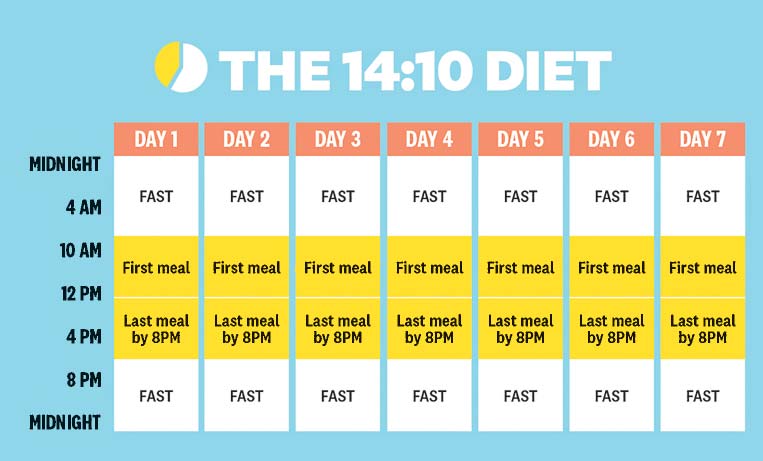In the world of diet and nutrition, there are numerous renditions of types of diets to choose from or to follow. The current growing trend is intermittent fasting. A few questions surround the culture of intermittent fasting with its growing popularity.
To have a better understanding, we will look at the types and consider the pros and cons of intermittent fasting. Intermittent fasting is described as periods and or cycles of fasting and eating.
It is a way of reducing the amount of calorie intake, helping to cut back on unhealthy foods or snacks, and disciplining oneself to reduce portion intake hence hoping to achieve weight loss.
One must be ready to figure out what would work best for them and how it would fit the lifestyle. It is not simply a onesize-fits-all approach. There are various types of intermittent fasting to explore. Explained are some of the most popular methods.
1. Time-restricted eating (the 16/8 and 14/10 method)
With this option, there is a fixed fasting and eating periods. For instance, fasting for 16 hours of the day and eating for the next 8 hours. This method is particularly easy or more convenient since sleeping covers most of the fasting period, breakfast is skipped and eating begins from the lunch period. Some common periods for 16/8 are only eating from 10am to 6pm and 12pm to 8pm, period for 14/10 is only eating from 9am to 7pm. It might take a few days to figure out if this pattern suits, especially if a person is very active and or gets hungry early in the morning.
2. Twice-a-week method (5/2 method)
This method focuses on providing only 500kcal for two days of the week. On the other five days consumption of healthy meals is recommended. The two days of fasting need to be in between non-fasting days. Care should be taken when consuming 500kcal meals on fasting days, focusing on high fibre and high protein meals mostly.
3. Alternate day fasting
With this type of fasting, every other day calories are reduced by 25 per cent of the normal consumption of food. There is a strict variation to this diet to include 0 calories on alternate days instead of the reduction of 25 per cent of the normal intake.
4. The 24-hour fast (or eat: stop: eat: method)
This method is followed once or twice a week where a full 24-hour fast is observed either from breakfast to breakfast or lunch to lunch. The side effects of this version can be extreme such as headaches, irritability, hunger, and low energy.
The pros and cons
A study has indicated that a certain intermittent fasting (12-24 hours: last meal at 7pm and first meal at 7am) has seemed to decrease the risk of Alzheimer’s disease therefore decreasing the risk of the clinical manifestation of dementia, however, the trial on humans is limited and other lifestyle factors such as physical activity has an input in a reduction in cognitive weakening in older people. An article suggests that intermittent fasting is effective in producing weight loss due to caloric restrictions, but is not a notable weight loss method. Further, diabetic patients opting for intermittent fasting need guidance from the health practitioner, nurse, and dietitian to adjust the medications associated with hypoglycemia, monitor glucose levels, and plan nutritional requirements respectively. Some studies have indicated that intermittent fasting improves cardiometabolic (heart attack, stroke, diabetes, insulin resistance, and nonalcoholic fatty liver disease) risk factors such as high blood pressure, LDL cholesterol and triglycerides levels, and HbA1c. To date, most studies done are short-run and have mostly been tried on animals, hence protocols to manage weight loss long-term are poorly understood with intermittent fasting. Intermittent fasting is not for every person, as some may have eating disorders, have medical conditions, or are undergoing treatment. Athletes require optimal nutritional needs to improve and excel in performance. Nevertheless, intermittent fasting works well for some, but is not a definite gateway to improved health. It can be a lifestyle habit that a person can choose. It requires focus, discipline, guidelines, and or consultation from a dietitian in planning and executing appropriate individual nutritional requirements.
Takeaway tips
• Reduce nighttime snacking (as a trial for fasting) • Go slow. • Find a method that would suit you best and your lifestyle. • As you come out of the fasting period (with whichever method is chosen), opt for nutritious meals and snacks such as lean protein, vegetables, whole grains, fruits, nuts, and seeds. • Increase hydration with water only. References https://academic.oup.com/nutritionreviews/adva nce-article/doi/10.1093/nutrit/ nuad021/7116310
https://health.clevelandclinic.org/intermittentfa sting-4-different-types-explained/
• ATIATUL NISHA is a dietitian at the Oceania Hospitals Pte Ltd. The views expressed in this article are not necessarily the views of this newspaper.



